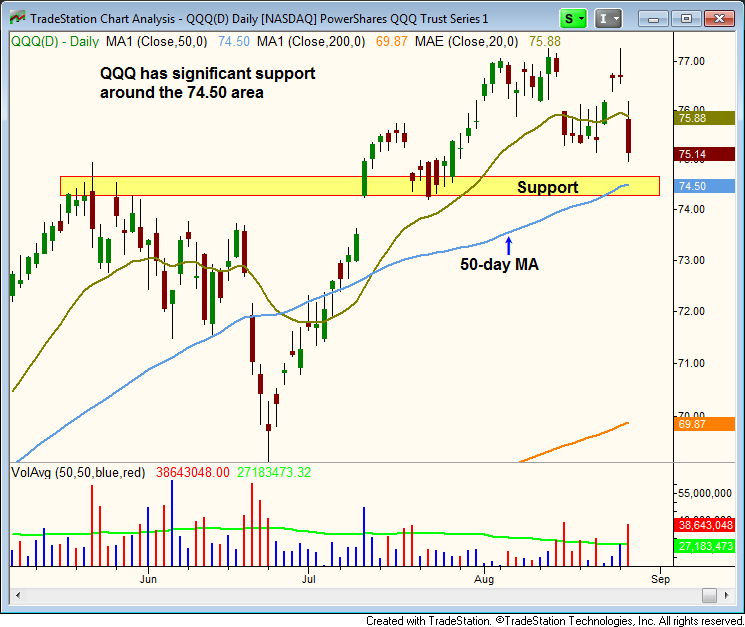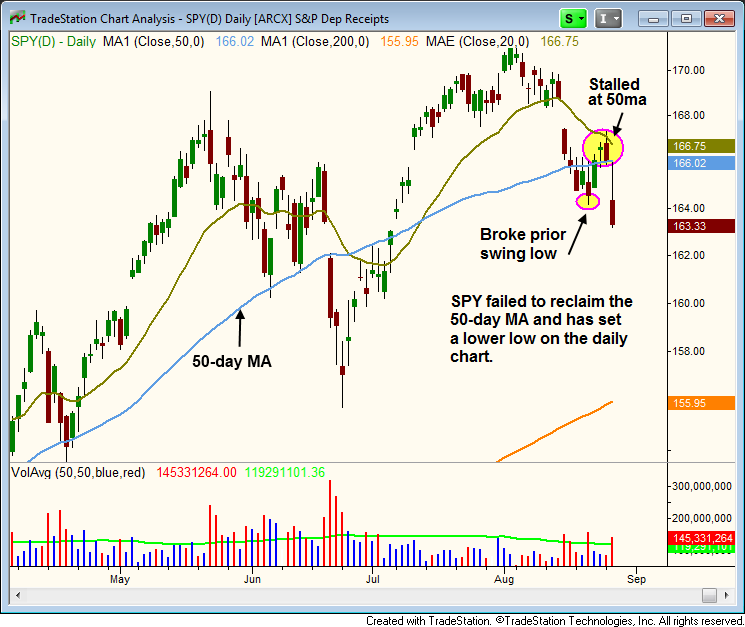| The Wagner Daily ETF Report For August 28 |
| By Deron Wagner |
Published
08/28/2013
|
Stocks
|
Unrated
|
|
|
|
The Wagner Daily ETF Report For August 28
We have mentioned several times recently that the NASDAQ has been the lone holdout in the broad market, in terms of holding above its 50-day moving average. Even with yesterday's sharp losses, the index is still above this important level of support (but now within 1% of it). This is shown below on the daily chart of PowerShares QQQ Trust ($QQQ), a popular ETF proxy for the Nasdaq 100 Index (which has a similar chart pattern to the NASDAQ Composite):

Despite yesterday's swift drop that caused $QQQ to break support of its prior swing lows from last week, notice the index is now less than 1% above a major level of horizontal price support that was formed by the prior highs of May, the lows of mid-July, and the 50-day moving average.
Conversely, the S&P 500 is now trading firmly below its 50-day moving average. As you can see on the chart of S&P 500 SPDR ($SPY) below, the benchmark S&P 500 is technically in much worse shape than the NASDAQ:

Before yesterday's decline, $SPY had managed to reclaim support of its 50-day moving average. However, the index only managed to hold above that pivotal level for two days before falling back down (in a big way). The Dow Jones is in even worse shape because the index is already testing crucial support of its June 2013 lows. By comparison, notice how far above their respective June lows both the NASDAQ and S&P 500 remain.
For now, our market timing system remains in "neutral" mode. The only reason it has NOT yet shifted to "sell" mode is because the NASDAQ continues to hold above key, intermediate-term support of its 50-day moving average.
Nevertheless, if the NASDAQ joins the S&P 500 and Dow Jones Industrial Average in breaking down below its 50-day moving average as well, there would no longer be any reason to be on the long side of the market (with the exception of ETFs with low correlation to stock market direction).
Because we are trend traders, a shift to "sell" mode would also enable us to start selling short (stocks with relative weakness) and/or maintain a heavy cash position. All bets for individual stocks on the long side of the market would be off.
As you may recall from our August 18 ETF commentary, we have been bullish on both Oil and Silver ETFs (and, to a lesser degree, Gold) for the past week.
Yesterday, that patience paid off because $USO (crude oil ETF) convincingly broke out above key resistance of an 8-week base of consolidation. Take a look:

After yesterday's 2.4% gain, our current position in $USO is now showing an unrealized share price gain of nearly 8% since our buy entry. Also, the position in our leveraged Silver ETF ($AGQ) is now up approximately 10% since our August 21 buy entry.
When the broad market is down sharply, as it was yesterday, the benefits of trading ETFs (as opposed to only stocks) really become clear.
Unlike stocks, most of which are correlated to the direction of the broad market, ETFs enables traders and investors to still profit in a down market because many types of ETFs have low to zero correlation to the overall stock market direction.
Commodity ETFs such as $USO and $AGQ are two great examples of the above.
Deron Wagner is the Founder and Head Trader of both Morpheus Capital LP, a U.S. hedge fund, and MorpheusTrading.com, a trader education firm.
|